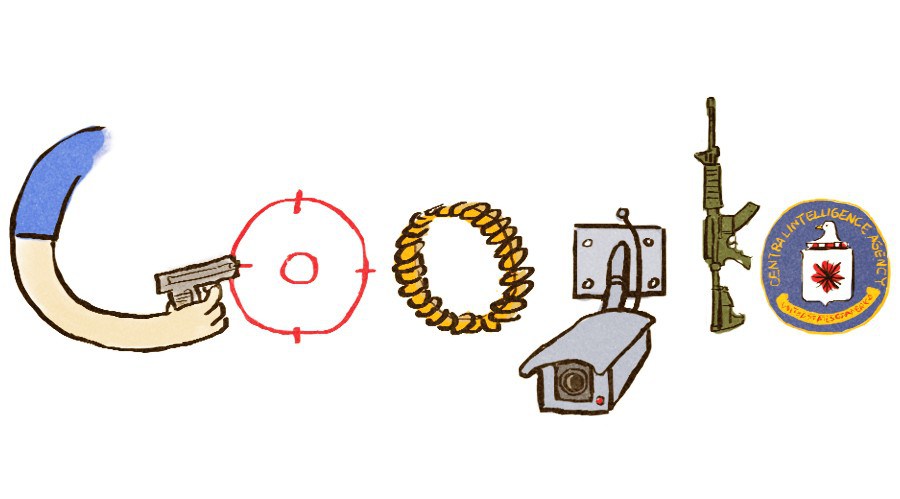Know your history: Google has been a military-intel contractor from the very beginning

"Google has partnered with the United States Department of Defense to help the agency develop artificial intelligence for analyzing drone footage, a move that set off a firestorm among employees of the technology giant when they learned of Google’s involvement." — Gizmodo / March 6, 2018
Gizmodo's March report on Google's work for the Pentagon has been making headlines across the world. It's also thrown the normally placid halls of Google's Mountain View HQ into chaos. Seems that Googlers can't believe that their awesome company would get involved in something as heinous as helping the Pentagon increase its drone targeting capability. And in April, Google employees went so far as to send their CEO a protest letter asking that the company back out of military-related AI research.
That's good news!
But the fact that Google helps the military build more efficient systems of surveillance and death shouldn't have been surprising, especially not to Google employees. The truth is that Google has spent the last 15 years selling souped-up versions of its information technology to military and intelligence agencies, local police departments, and military contractors of all size and specialization — including outfits that sell predictive policing tech deployed in cities across America today.
As I outline in my book Surveillance Valley, it started in 2003 with customized Google search solutions for data hosted by the CIA and NSA. The company's military contracting work then began to expand in a major way after 2004, when Google cofounder Sergey Brin pushed for buying Keyhole, a mapping startup backed by the CIA and the NGA, a sister agency to the NSA that handles spy satellite intelligence.
Spooks loved Keyhole because of the "video game-like" simplicity of its virtual maps. They also appreciated the ability to layer visual information over other intelligence. The sky was the limit. Troop movements, weapons caches, real-time weather and ocean conditions, intercepted emails and phone call intel, cell phone locations — whatever intel you had with a physical location could be thrown onto a map and visualized. Keyhole gave an intelligence analyst, a commander in the field, or an air force pilot up in the air the kind of capability that we now take for granted: using digital mapping services on our computers and mobile phones to look up restaurants, cafes, museums, traffic conditions, and subway routes. "We could do these mashups and expose existing legacy data sources in a matter of hours, rather than weeks, months, or years," an NGA official gushed about Keyhole — the company that we now know as Google Earth.
Military commanders weren’t the only ones who liked Keyhole's ability to mash up data. So did Google cofounder Sergey Brin.
The purchase of Keyhole was a major milestone for Google, marking the moment the company stopped being a purely consumer-facing Internet company and began integrating with the US government. While Google’s public relations team did its best to keep the company wrapped in a false aura of geeky altruism, company executives pursued an aggressive strategy to become the Lockheed Martin of the Internet Age. “We’re functionally more than tripling the team each year,” a Google exec who ran Google Federal, the company's military sales division, said in 2008.
It was true. With insiders plying their trade, Google’s expansion into the world of military and intelligence contracting took off.
What kind of work?
Here are just a few data points from Surveillance Valley:
-
"In 2007, it partnered with Lockheed Martin to design a visual intelligence system for the NGA that displayed US military bases in Iraq and marked out Sunni and Shiite neighborhoods in Baghdad— important information for a region that had experienced a bloody sectarian insurgency and ethnic cleansing campaign between the two groups."
-
"In 2008, Google won a contract to run the servers and search technology that powered the CIA’s Intellipedia, an intelligence database modeled after Wikipedia that was collaboratively edited by the NSA, CIA, FBI, and other federal agencies."
-
"In 2010, as a sign of just how deeply Google had integrated with US intelligence agencies, it won a no-bid exclusive $27 million contract to provide the NGA with “geospatial visualization services,” effectively making the Internet giant the “eyes” of America’s defense and intelligence apparatus."
-
"In 2008, Google entered into a three-way partnership with the NGA and a quasi-government company called GeoEye to launch a spy satellite called GeoEye-1. The new satellite, which was funded in large part by the NGA, delivered extremely high-resolution images for the exclusive use of NGA and Google."
- A few years ago it started working with PredPol, a California-based predictive policing startup. "PredPol did more than simply license Google’s technology to render the mapping sys- tem embedded in its product but also worked with Google to develop customized functionality, including 'building additional bells and whistles and even additional tools for law enforcement.'"
More from the book:
"Google has been tightlipped about the details and scope of its contracting business. It does not list this revenue in a separate column in quarterly earnings reports to investors, nor does it provide the sum to reporters. But an analysis of the federal contracting database maintained by the US government, combined with information gleaned from Freedom of Information Act requests and published periodic reports on the company’s military work, reveals that Google has been doing brisk business selling Google Search, Google Earth, and Google Enterprise (now known as G Suite) products to just about every major military and intelligence agency: navy, army, air force, Coast Guard, DARPA, NSA, FBI, DEA, CIA, NGA, and the State Department. Sometimes Google sells directly to the government, but it also works with established contractors like Lockheed Martin, Raytheon, Northrop Grumman, and SAIC (Science Applications International Corporation), a California-based intelligence mega-contractor that has so many former NSA employees working for it that it is known in the business as 'NSA West.'"
—Yasha Levine
Originally published on March 06, 2018. Updated on April 5, 2018
Want to know more?
Read "Surveillance Valley: The Secret Military History of the Internet"
